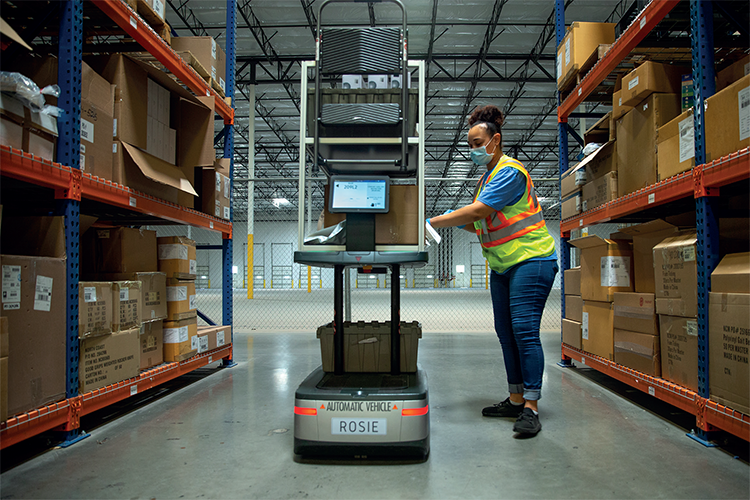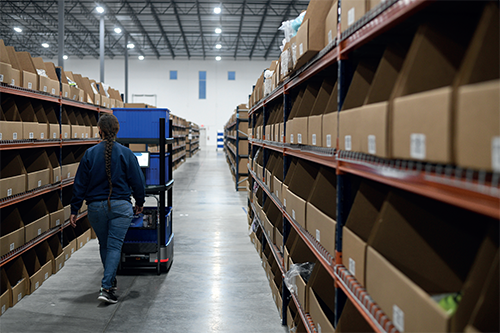
Adapt to survive
Global supply chains have faced a torrent of challenges in recent years. These include the pandemic, sudden and unexpected changes in demand and labor shortages so acute that some warehouses have been obliged to offer sign-on bonuses for new recruits.
Flexible fulfilment is crucial to enable firms to cope with these operational challenges, enabling them to become more resilient without weakening competitiveness.
Operational challenges.
Fluctuating demand
It is important to review fulfilment infrastructure regularly to ensure that it has the flexibility to add capacity and adapt to market changes quickly. For example, e-commerce boomed during the pandemic; what remains unclear is how much volume will be retained at the expense of stores.
This underlines the importance of flexibility. If you don’t know what proportion of your revenues will come from e-commerce in relation to in-store sales, it is hard to make a multi-decade commitment in fixed automation to support your supply chain.
Other factors such as shifting consumer preferences and peak periods also make it hard to predict demand. A flexible solution can help companies to fulfil orders, ship them on time and ensure customers remain happy.
Labor shortages
Robots can help warehouse managers tackle the current labor shortage by enhancing productivity, automating manual and repetitive tasks, and enabling colleagues to focus on where they are most needed.
Robots can also address the barriers deterring people from working in the sector, according to a recent survey.
A survey by 6 River Systems suggests that people are put off working in warehouses and fulfilment centers by the physical nature of the work, which often involves pushing a heavy trolley to pick or pack items.
However, 35 percent of respondents who didn’t work in a warehouse or fulfilment center said that they would consider working in one if such barriers could be overcome.
What is flexible fulfilment?
Automation
Many warehouse managers consider automation as a solution to their current challenges, but old-style fixed automation is slow and expensive to implement and has often failed to adapt to changing market conditions. It involves high maintenance costs and often has single points of failure.
However, delaying the decision to automate is not realistic. Increasing costs resulting from inflation, rising consumer expectations of rapid delivery fueled by Amazon and Click and Collect services and labor shortages are putting greater pressure on the supply chain. In response, firms are embracing automation that can be deployed rapidly without disrupting operations.
Collaborative robots
Collaborative robots, such as Chuck by 6 River Systems, are a key element of automation in warehouses and can be used in all picking, counting, replenishment and sorting tasks. They harness machine learning and artificial intelligence to help colleagues work faster while making their jobs less physically demanding. These robots lead associates through their work zones to help them minimize walking, stay on task and work more efficiently.
Collaborative robots also prevent collisions and reduce the risk of accidents, as they detect obstacles and always choose the most efficient route to their destination.
The size and configurability of the robot affects how flexible it is. If too small, it will rapidly fill up to capacity. As a result, you need more small robots to do the same volume of work as larger robots. Goods in warehouses come in all shapes and sizes, so to transport them it is best to use a robot that is highly configurable.
Increased visibility and performance
Collaborative robots also increase visibility and performance in the warehouse. When controlled by advanced software, collaborative robots can raise pick rates significantly and shorten walking distances for employees.
Sophisticated fulfilment software linked to warehouse management systems can divide incoming orders into different categories. The software determines the ideal route with the shortest possible transit time to process the orders. Cloud-based algorithms group orders with the same pick requirements and distribute the work to individual robots as needed to minimize employee walking.
This fulfilment software is compatible with any warehouse management system and can be integrated into any warehouse layout in just a few weeks. The number of robots can also be increased or decreased within the same timeframe to help deal with peak and quiet periods.
This software, along with the collaborative picking robots it powers, makes warehouse operations far more flexible and able to cope with challenges such as labor shortages, fluctuations in demand and rising customer expectations of rapid delivery – challenges to which many firms are now having to become accustomed.

Simon Jones is Head of UK & Ireland, 6 River Systems, a leading fulfilment solutions provider. Founded in 2015, it is based in Massachusetts, USA, and is owned by Shopify.
https://6river.com/